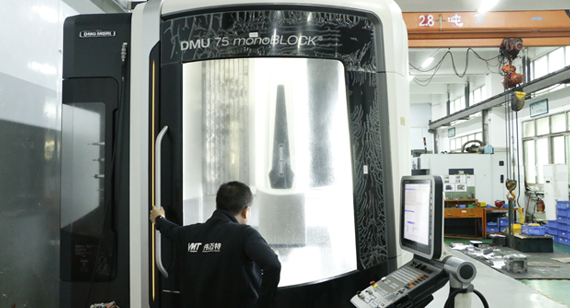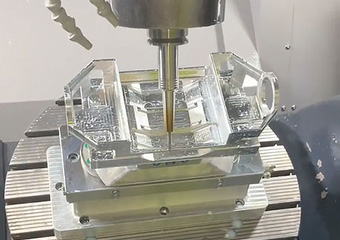15 years one-stop China custom CNC machining parts factory

Hey there I’m VMT Sam!
With 25 years of CNC machining experience we are committed to helping clients overcome 10000 complex part-processing challenges all to contribute to a better life through intelligent manufacturing. Contact us now
 151 |
Published by VMT at Mar 27 2024
151 |
Published by VMT at Mar 27 2024
In the field of CNC machining part manufacturing, 5-axis CNC machining technology, with its characteristics of high precision, efficiency, and flexibility, is widely applied in the fabrication of various complex components. However, for many factories and businesses considering or encountering 5-axis CNC machining for the first time, a common question arises: What is the maximum part size for 5-axis CNC machining? This article will delve into this question, helping readers better understand and apply 5-axis CNC machining technology.

Firstly, it's essential to grasp the basic principles and characteristics of 5-axis CNC machining. This technology utilizes five coordinate axes (typically X, Y, Z, and two rotational axes A and C or B and C) to precisely control the motion of the tool and the workpiece, enabling the machining of complex surfaces and shapes with high precision. This capability is particularly suitable for industries such as aerospace, automotive, and mold making, where strict requirements for part precision and complexity exist.

So, what determines the maximum part size for 5-axis CNC machining? In fact, there is no fixed answer to this question, as it depends on several factors working together.
Machine Tool Specifications and Size:
The specifications and size of the 5-axis CNC machine tool are crucial factors determining the maximum part size. Different machine tool models and specifications vary in terms of their worktable size, travel range, and the maximum part size they can accommodate. Therefore, when selecting a 5-axis CNC machine tool, it's necessary to choose a model with suitable specifications and performance according to the actual machining requirements.
Tooling and Fixturing Systems:
Tooling and fixturing systems also play a significant role in determining the maximum part size for 5-axis CNC machining. For larger parts, appropriate tooling and fixturing systems need to be selected to ensure stability and precision during the machining process. Additionally, the design and manufacture of fixtures should consider the size and shape of the part to securely hold it and prevent movement or deformation during machining.
Control Systems and Programming Software:
The control system and programming software for 5-axis CNC machining are also factors influencing the maximum part size. Advanced control systems and programming software enable precise control of complex machining paths, thus improving machining efficiency and quality. Therefore, when choosing a 5-axis CNC machine tool, consideration should also be given to the performance of its control system and the usability of its programming software.
Machining Processes and Material Properties:
Machining processes and material properties also affect the maximum part size for 5-axis CNC machining. Different materials and machining processes have varying requirements for machine tools. Therefore, suitable machining parameters and tooling should be selected based on the characteristics of the material and the process to ensure smooth machining.
Considering the aforementioned factors, we can determine the maximum part size for 5-axis CNC machining through the following steps:
Clarify Machining Requirements:
Firstly, it's necessary to clarify the size, shape, and precision requirements of the part to be machined, as well as the batch size and production cycle requirements.
Select the Right Machine Tool:
Based on the machining requirements, choose a 5-axis CNC machine tool with appropriate specifications and performance. Pay attention to factors such as the machine tool's worktable size, travel range, and the maximum part size it can accommodate.
Optimize Tooling and Fixturing Systems:
For machining larger parts, select suitable tooling and fixturing systems to ensure stability and precision during the machining process.
Utilize Advanced Control Systems and Programming Software:
Leverage advanced control systems and programming software to achieve precise control of complex machining paths, thereby improving machining efficiency and quality.
Consider Machining Processes and Material Properties:
Take into account the characteristics of the material and the machining process to select suitable machining parameters and tooling, ensuring smooth machining.

In conclusion, the maximum part size for 5-axis CNC machining is not a fixed value but depends on multiple factors. In practical applications, we need to determine the maximum part size based on specific machining requirements and machine tool performance. By continuously optimizing tooling and fixturing systems, leveraging advanced control systems and programming software, and considering machining processes and material properties, we can further expand the application range and capabilities of 5-axis CNC machining.
As experts in the field of CNC machining part manufacturing, it's crucial to closely monitor the development trends of 5-axis CNC machining technology, continually learn and master new technologies and processes, and contribute to the industry's sustained development and innovation. Additionally, strengthening communication and collaboration with enterprises can jointly promote the popularization and application of 5-axis CNC machining technology, facilitating the advancement and development of the entire industry.
We hope this article provides valuable insights and references for readers in understanding and applying 5-axis CNC machining technology. In the future, we have reason to believe that 5-axis CNC machining technology will play an even greater role in various fields, providing strong support for the transformation and upgrading of the manufacturing industry.
Ready To Start Your Next Project?
Get Instant Quote

Request a Free Quote
Send us a message if you have any questions or request a quote. We will get back to you ASAP!